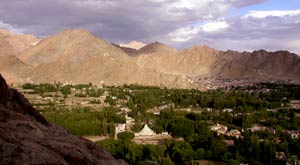Leh - The Capital City
The Indus Valley is the geographical backbone of Ladakh. It is home to the largest concentration of villages and people, as well as monasteries, monuments and places of historical importance. Leh, the ancient capital of Ladakh nestles along its left bank slopes. Leh is a historic town, having been the Royal Capital of the old kingdom since the 15th century, and the Caravan Centre of Central Asian trade. It was the first capital of King Takspa Bum-lde who ruled over the area from 1400 to 1430 CE. He is believed to have built the 'Red Chapel' containing the 3-storey high statue of the Maitreya Buddha, as well as the Stupa of Ti-siru or Ti'u-Tashis Od-phro containing 108 temples, on the Tiu-Serpo hill.
The first recorded fort at Leh was the Namgyal Tsemo castle built by King Tashi Namgyal (1500-1530) on the hill overlooking the town. Of the fort only the ruined remains are found, but the associated temples are intact, and maintained by Sankar monastery. The complex comprises the Maitreya Temple and the Gon-khang containing a large image of the 6-armed Mahakala with a protruding phallus, which is superstitiously worshipped by barren women wishing to bear a child. Behind the fort walls, the remains of even more ancient fortifications are seen. These are locally known as Dard Castle (Dok-khar) indicating that there was a castle here even before the establishment of the ruling dynasty of Tibetan origin. On the hill below Namgyal Tsemo is the nine-storey Leh Palace (Lhachen Palkhar) built by King Singge Namgyal in 1600 AD in the grand tradition of Tibetan fort architecture. It is said to have inspired the design of the famous Potala in Lhasa built about half a century later.
 |
|
For long a bustling crossroads of the migration & trade routes, Leh is by itself a sightseeing attraction. Strolling along its lanes and by-lanes, observing the varied crowd and looking into the curio shops is an engaging experience. From the head of the main Bazaar begins the old alleyways and piled-up houses of the old town, clustering around the foot of the Palace Hill. The head of the Bazaar is dominated by the Jamia Masjid, which was built during 1666-67 on a land grant offered by King Deldan Nmagyal. The present structure has been built many times and lost the original characteristic although it is much expanded in size. Also located within the main market area is the Jo-Khang commonly known as Gompa Soma (or New Monastery), built in 1957 by the Ladakh Buddhist Association. Behind the main Bazaar, Nau Shehar (formerly called Chang- Gali) has interesting little shops selling curios and jewellery. The old labyrinthine alleyway system around the foot of the Palace Hill, is now partly developed into a road system. In the other direction, down the bazaar, are the Tibetan markets where one can bargain for pearls, turquoise, coral, lapis lazuli and many other kinds of semi-precious stones and jewellery, as well as carved yak-horn boxes, quaint brass locks, china or metal bowls, or any of a whole array of curios. Moti Market is another bustling system of narrow streets & alleyways lined with hundreds of small shops & kiosks. There are many handicraft show rooms in the main market which stock local handicrafts such as handmade carpets, woolen shawls, dragon paintings, thangkas, lacquered tea-tables, etc., all ideal picking as souvenirs.
|

